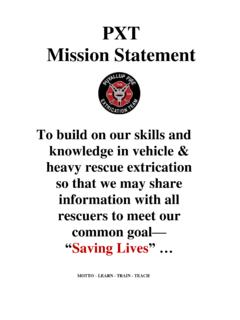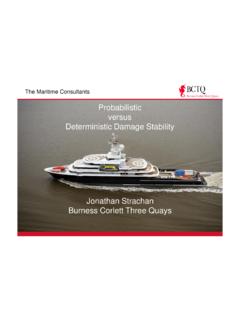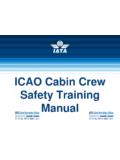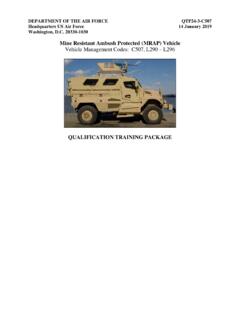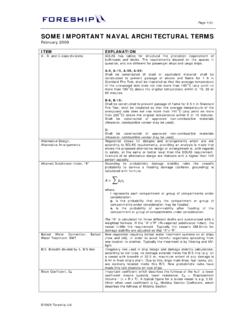Transcription of Vehicle Extrication Classroom Notes
1 LEARN - TEACH - TRAIN 1 Vehicle Extrication Classroom Notes Contents: NFPA 1670, Chapter 6 Vehicle Anatomy/Terminology/Construction Crash Types Rescue Action Plan Scene Safety Considerations Initial Activities Common To Most Rescues Vehicle Stabilization Disentanglement Evolutions; Doors, Roof, Dash Patient Removal Techniques World Rescue Organization Facts First Due Engine Company PBT LEARN - TEACH - TRAIN 2 NFPA 1670, Chapter 6 The short version Awareness Level Competencies Sizing up existing and potential conditions Identifying resources needed Implementing agency response Controlling and managing the scene Implementing initial traffic control Operations Level Identifying victim locations/survivability Making the scene safe (isolation/stabilization)
2 Identifying and controlling fuel leaks Patient protection/packaging Gaining access to trapped patients Use of hand tools to access/disentangle Mitigating scene hazards Gathering necessary resources Additional traffic control measures Establishing operational work zones; hot, warm, cold Recognizing and working around Supplemental Restraint Systems Understanding Vehicle design and construction features Knowledge of crash types/ mechanisms of injury Basic Vehicle stabilization techniques Technical Level Competencies Extrication /disentanglement from large vehicles bus, trains, truck Advanced stabilization vehicles not on their wheels Use of air lifting bangs Use of chains, wire rope, winches Utilization of heavy wreckers for rescue Use of power tools hydraulic, pneumatic.
3 Electric LEARN - TEACH - TRAIN 3 Vehicle Anatomy/Terminology Use driver and passenger side as opposed to left and right when referring to Vehicle Roof components - Roof posts A to Z from front to rear - Roof rail - Roof rib Doors -Safety latch assembly -Nader pin assembly -Side impact bars Rocker channel Dash/firewall assembly -Steering column -Dash support bar/pipe -Top rail/strut tower landmarks Front/rear quarter panels Laminated safety glass used in windshields and throughout in some vehicles, must saw Tempered safety glass used in side and rear windows, can break with tool LEARN - TEACH - TRAIN 4 Vehicle Construction Body On Frame (BOF) Construction It s the mounting of a separate body to a rigid frame which supports the drive train.
4 In 1997 regulations changed BOF vehicles and how impact forces travel through them. Newer BOF designs are intended to react to a collision in much the same way as a UNI-body, however there are several differences that must be considered. BOF Vehicles have separate frames that are made of thicker, heavier metal. Weight and mass of larger BOF bodies will affect channeling of impact energy differently than UNI-body. BOF bolted body sections absorb energy differently than welded structures. Impact energy will telescope further along the BOF frame. UNI-body Construction Is in which the body is integrated into a single unit with the chassis rather than having a separate body-on-frame. The welded "Unit Body or Uni-Body" is the predominant automobile construction technology today.
5 UNI-body vehicles are designed to fold and collapse as they absorb the impact of the collision and protect the passenger compartment. The front and rear body portions are designed to: Deform easily Collapse in a predetermined fashion (crush zones) Form a structure that absorbs initial impact energy and directs remaining damage through the Vehicle . Preserve the passenger compartment. For the most part all of today s passenger vehicles are made of a form of UNI-body construction. LEARN - TEACH - TRAIN 5 Space Frame Cage like steel structure from BOF or UNI-body designs in that is uses steel frame members to form a load-bearing cage that carries vehicles stresses and holds vehicles together. Passive Safety Design Modern Vehicle design incorporates a number of built-in safety features, which are referred to as passive safety.
6 Passive Safety is meant to maximize passenger protection by channeling and absorbing impact forces throughout the entire Vehicle and by creating a protective shell for passengers. Example: A head-on collision with a barrier at 20 mph may cause the engine to move as much as 2-4 inches, while the passenger compartment may compact by as little as 1 to 2% of its length. While passive safety design was originally a major feature of only UNI-body construction, many passive safety features have now been incorporated into the design and construction of newer BOF vehicles. Newer BOF designs incorporate holes, convolutions, and other shapes which absorb energy. Vehicle Materials and Processes High-Strength Steel - Specially formulated steel used to reinforce selected areas of vehicles.
7 High-Strength, Low Alloy (HSLA) - Specially formulated steel designed to be lightweight yet strong enough to reinforce selected areas of a Vehicle , 40,000-70,000 psi tensile strength. Micro Alloy Steel - Specific steel designed to be lightweight yet structurally sound, 110,000-215,000 psi tensile strength. LEARN - TEACH - TRAIN 6 Boron Steel - This metal is extremely strong, due in part, to its high phosphorous micro alloy content making it resistance to bending or crushing. Recip saws, air chisels, will not work. Hydraulic tools will squeeze the Boron and could twist/scissor or shatter the hydraulic cutter blades. Aluminum - Lightweight metal used to form Vehicle frames and outer body panels. Aluminum Alloy - Special mix of chemical ingredients added to aluminum to increase the strength of aluminum.
8 Ultra Light Steel Auto Body Construction (ULSAB) - Unique new manufacturing process in which large sections of the Vehicle body are manufactured as a single unit. This results in fewer presses and pieces during manufacturing. ULSAB bodies are lighter, stronger, and less expensive to manufacture. The full implication of this new design is still being learned. Hydro forming - Allows steel to be preformed to near design in a die or mold, and allows the manufacturer to form more complicated designs using one piece of material. Plastic Materials - Components of a Vehicle that consists of various types of synthetic materials. LEARN - TEACH - TRAIN 7 Collision Types Head on accident - Frontal vs. Offset frontal collision T-bone/ broadside Rear end Rollover onto side - Resting on tire edge - Resting on roof edge Rollover onto roof - Pancake from crushing roof posts - Engine down is most common position Vehicle under-ride/ over-ride - Normally smaller Vehicle trapped under larger object - Example of car vs.
9 Semi trailer Rescue Action Plan Arrival/Positioning/ICS - Create safe work zone with parking of rigs - Uphill, upwind, shield work area - Establish Extrication , medical sectors, safety officer as needed Scene size-up and survey Scene stabilization - Fire protection, dry chem. And hose line - Hazards located and mitigated - Vehicles stabilized Patients accessed and triaged Disentanglement (tool work) -Relieve entrapments and create removal pathway Extrication (removal) of patient from Vehicle and transport LEARN - TEACH - TRAIN 8 Size-up Considerations Can start en-route to call with dispatch info - Number and type of vehicles? - Confirmed entrapment? People not getting out of vehicles? - Power poles involved/ lines down? Standard crew assignments to avoid confusion and save time - Size-up and walk around 360 done by officer - Initial Vehicle stabilization and patient contact by firefighter - Hose line/lighting/tool staging by driver Outer/ Inner circle survey techniques - Outer additional vehicles, walk away or ejected patients, hazards, back up for inner circle firefighter - Inner hot zone survey to check for hazards, number of patients, severity of injuries, entrapment, fluid leakage Common Scene Hazards From the Vehicle - Silent running hazard (Hybrid & EV Vehicles)
10 - Leaking fluids fuel, battery acid - Blood sharps from jagged metal and broken glass - Un-deployed airbags - Hood and hatch struts - Compressed strutted bumpers - Hazmat - Weapons/Pets From the surroundings - Traffic/ distracted drivers - Wires down park 1 span length away, call power company - Electrical transformers - Broken power poles - Trip hazards - Water, slippery terrain LEARN - TEACH - TRAIN 9 Vehicle Stabilization Any crash damaged Vehicle considered unstable Stabilization must be maintained and rechecked Minimizes Vehicle reaction to rescue efforts and painful movements for patient Upright Vehicle Chock wheels, set brake horizontal stabilization Block, step chock occupant compartment at minimum of 2 points vertical stabilization Side resting Vehicle Crib voids with wedges, step chocks Lock in place with jacks, struts, straps, chains Inverted Vehicle Wedges at front end Fill voids with cribbing Struts, jacks at rear of Vehicle Patient Contact/Access Make verbal contact with patient as soon as possible and give instructions, ie: Don t move your head/neck calm and reassure pt.

